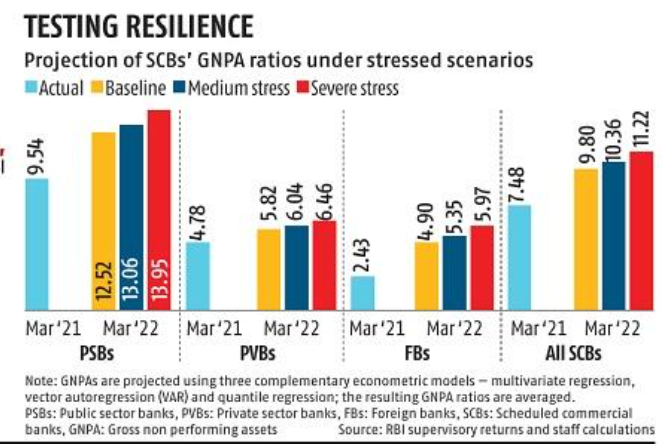ForumIAS announcing GS Foundation Program for UPSC CSE 2025-26 from 27th May. Click Here for more information.
Sources: The Hindu, The Business Standard (Article 1, Article 2)
Syllabus: Indian Economy and issues relating to planning, mobilization, of resources, growth, development and employment.
Relevance: The problem of NPA is still impacting the Indian economy and the recent Financial Stability Report also highlights it.
About the news:
The Reserve Bank of India (RBI) recently launched its half-yearly Financial Stability Report. The report highlighted that the gross non-performing asset ratio (GNPA) of India’s scheduled commercial banks (SCBs) may climb by the end of the current fiscal year to as much as 11.2% under a severe stress scenario, from 7.48% in March 2021.
About the Financial Stability Report:
The half-yearly FSR report is a collective assessment of the Financial Stability and Development Council (FSDC) sub-committee. It assesses the economy on risks to financial stability and the resilience of the financial system. All regulators take part in making the report, and it is released by the RBI.
Key highlights of the Financial Stability Report:
Source: Business Standard
- The report mentions the “GNPA ratio of SCBs may increase by March 2022”. The report mentions that the banks have sufficient capital to take care of NPAs.
- The capital to risk-weighted assets ratio of SCBs increased to 16.03%, and the provisioning coverage ratio stood at 68.86% in March 2021.
- Policy support has helped in shoring up the financial positions of banks, containing non-performing loans, and maintaining solvency and liquidity globally.
- On the domestic front, the ferocity of the second wave of COVID-19 has dented economic activity. But the monetary, regulatory, and fiscal policy measures have helped curtail the solvency risk of financial entities, stabilize markets. Further, these measures also help the financial entities to maintain their financial stability.
- Large borrowers make up the lion’s share of a bank’s bad debt even now. The share of large borrowers in the aggregate loan portfolio of banks stood at 52.7 per cent in March 2021. But they accounted for 77.9 per cent of the total gross non-performing assets (NPA).
- The pandemic has hit consumers and smaller businesses the hardest. Demand for consumer credit across banks and non-banking financial companies (NBFCs) has dampened.
- Public sector banks grew their credit book by only 3.2 percent. On the other hand, private counterparts expanded their credit book by 9.9 per cent year on year.
- Precautionary savings resulted in a deposit increase of 11.9 per cent.
- The report mentions new risks such as
- Future waves of the pandemic;
- Expansion of government market borrowing: The report has pointed out that banks are holding a high amount of government bonds. This is the highest since March 2010. This makes them sensitive to valuation changes.
- International commodity prices and inflationary pressures;
- Global spillovers amid high uncertainty;
- Rising incidence of data breaches and cyberattacks
- Improvement in health of banking sector: The RBI was expecting NPAs to climb to 12.5 per cent of advances under its baseline scenario a year ago. But under current projection’s it is what projected in a severe stress scenario also.
Suggestions mentioned in the report:
- The SCBs will need to reinforce their capital and liquidity positions to fortify themselves against potential balance sheet stress.
- The RBI also mentioned that the sustained policy support, benign financial conditions, and the gathering momentum of vaccinations were nurturing an uneven global recovery.
Terms to know:





